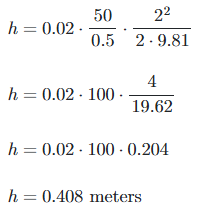Darcy-Weisbach Equations Calculator
Fluid Mechanics Hydraulics Formulas
Problem:
Solve for head loss.
Enter Calculator Inputs:
Can you share this page? Because, it could help others.
Solution:
Solution In Other Units:
Input Unit Conversions:
Change Equation or Formulas:
Tap or click to solve for a different unknown or equation
| Solve for head loss | |
| Solve for friction factor | |
| Solve for pipe length | |
| Solve for pipe diameter | |
| Solve for flow velocity | |
| Solve for acceleration of gravity |
| h | = | head loss |
| f | = | friction factor |
| L | = | pipe length |
| D | = | pipe diameter |
| V | = | flow velocity |
| g | = | acceleration of gravity |
Reference - Books:
Warren Viessman and Mark J. Hammer. 1993. Water Supply and Pollution Control. Harper Collins College Publishers, Inc. 5th ed.
Background
The Darcy-Weisbach equation is a rudimentary formula used in fluid mechanics to calculate head loss due to friction in a pipe. The equation aids in designing efficient piping systems by accounting for various factors such as pipe length, diameter, flow velocity, and friction factor. This essential equation is widely used in both academic research and industrial applications to ensure precise fluid transportation and system optimization.
The Equation
The Darcy-Weisbach equation for head loss (h) is expressed as:

Where:
- hL = Head loss (meters or feet)
- f = Friction factor (dimensionless)
- L = Length of the pipe (meters or feet)
- D = Diameter of the pipe (meters or feet)
- V = Flow velocity (meters/second or feet/second)
- g = Acceleration due to gravity (9.81 m/s² or 32.174 ft/s²)
How to Solve
To solve for the head loss using the Darcy-Weisbach equation, follow these steps:
Determine the Inputs:
- Friction factor (f) (dimensionless)
- Pipe length (L) (meters or feet)
- Pipe diameter (D) (meters or feet)
- Flow velocity (V) (meters/second or feet/second)
- Acceleration due to gravity (g) (9.81 m/s² or 32.174 ft/s²)
Insert the Inputs into the Equation:
Perform the Calculations:
- Calculate the velocity head

- Multiply the velocity head by the ratio of pipe length to diameter

- Multiply the result by the friction factor (f)
- Obtain the Head Loss: The result will be your head loss due to friction in the pipe.
Example
Assume you have the following data:
- Friction factor, f = 0.02
- Pipe length, L = 50 meters
- Pipe diameter, D = 0.5 meters
- Flow velocity, V = 2 meters/second
- Using the acceleration due to gravity g = 9.81 m/s²

The head loss is 0.408 meters.
Fields/Degrees It Is Used In
- Mechanical Engineering: For designing and analyzing fluid transportation systems.
- Civil Engineering: Applied in hydraulic analysis for water distribution and sewage systems.
- Chemical Engineering: For piping design in chemical processing plants.
- Environmental Engineering: Used in the design of water and wastewater treatment facilities.
- Marine Engineering: To compute losses in pipelines aboard ships and offshore platforms.
Real-Life Applications
- Municipal Water Supply Systems: Calculating head loss in the distribution network.
- Industrial Piping Systems: Designing efficient routes for transporting fluids.
- Oil and Gas Pipelines: Optimizing flow in long-distance pipelines.
- HVAC Systems: Calculating fluid dynamics in heating and cooling systems.
- Irrigation Systems: Ensuring efficient water supply in agricultural fields.
Common Mistakes
- Incorrect Unit Conversion: Failing to maintain unit consistency leads to inaccurate results.
- Assuming Constant Friction Factor: Not accounting for friction factor variations with flow condition changes.
- Neglecting Minor Losses: Ignoring additional losses due to fittings, valves, and bends.
- Overlooking Pipe Roughness: The friction factor can vary with pipe material and roughness, which is often overlooked.
- Ignoring Temperature Effects: Temperature changes can affect fluid viscosity and, subsequently, the friction factor.
Frequently Asked Questions (FAQs) with Answers
- Q: What is the Darcy-Weisbach equation used for?
A: The Darcy-Weisbach equation calculates the head loss due to friction in a pipe, which is crucial for designing efficient fluid transport systems. - Q: How do you find the friction factor in the Darcy-Weisbach equation?
A: Depending on the flow type (laminar or turbulent), the friction factor can be determined empirically or through the Colebrook-White equation. - Q: Can the equation be used for gas flows?
A: Yes, the Darcy-Weisbach equation can be applied to both liquid and gas flows as long as the appropriate properties and friction factors are used. - Q: Why is the acceleration of gravity included in the equation?
A: The acceleration of gravity is a fundamental part of the equation as it relates the flow's kinetic energy to the potential energy due to elevation changes. - Q: What is a typical range for the friction factor (f)?
A: For laminar flow, f = 64/Re where Re is the Reynolds number. For turbulent flow, f varies within the range of 0.01 to 0.05, depending on the pipe roughness and Reynolds number.
Online Web Apps, Rich Internet Application, Technical Tools, Specifications, How to Guides, Training, Applications, Examples, Tutorials, Reviews, Answers, Test Review Resources, Analysis, Homework Solutions, Worksheets, Help, Data and Information for Engineers, Technicians, Teachers, Tutors, Researchers, K-12 Education, College and High School Students, Science Fair Projects and Scientists
By Jimmy Raymond
![]()
Contact: aj@ajdesigner.com
Privacy Policy, Disclaimer and Terms
Copyright 2002-2015